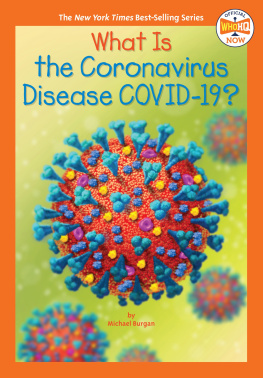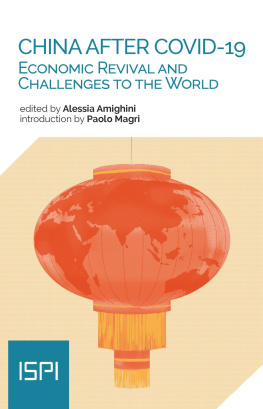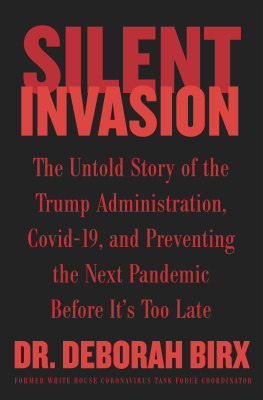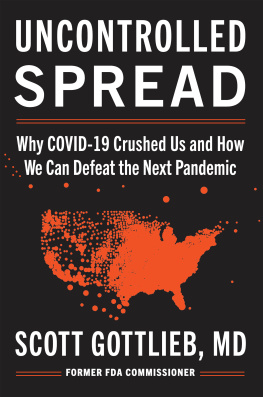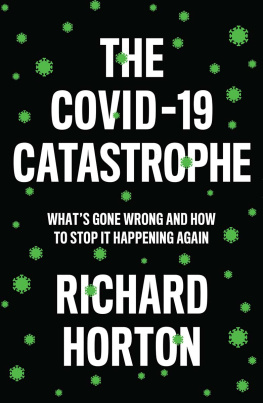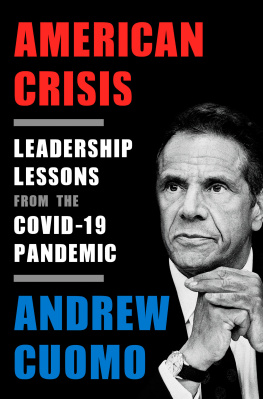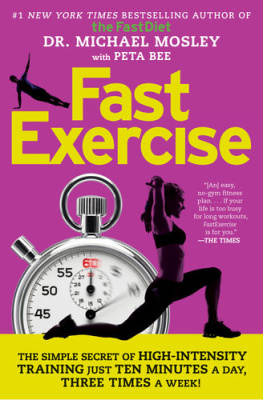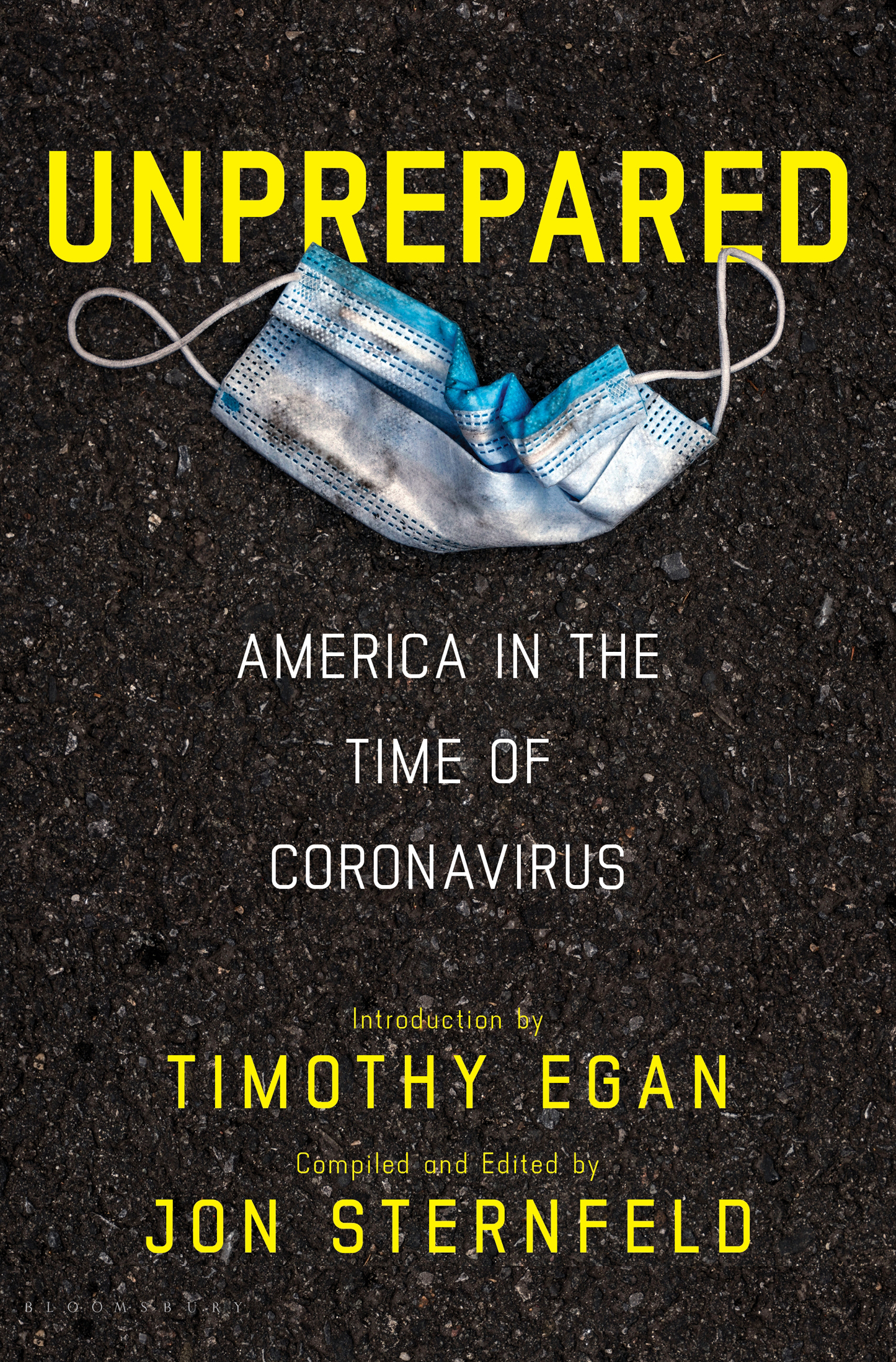Contents
Guide
Pagebreaks of the print version


CONTENTS
Everyone now asks: When will things get back to normal? But, as a physician and researcher, I fear that the resumption of normality would signal a failure to learn. We need to think not about resumption but about revision.
SIDDHARTHA MUKHERJEE,
AUTHOR AND PHYSICIAN
The pages that follow are the tick-tock of a tragedy, perhaps the greatest collapse of American society in so short a time, ever. You can read it and weepfor the dead, those family and friends you thought had ten more good years but instead did not have ten days. You can read it and rageat the idiocy, the indifference, the defiance of science. You can read it and feel humbled, even powerless, at the predatory power of a new virus to bring down the human species. Or you can read it and learn. Its all here without filter, the words of people who tried to save us from ourselves, and the words of those who betrayed us.
We know what happened. Theres no need to wait for the forensics from future historians. Why it happened on such a scale is the harder, more worthwhile question. The first reports came out of China in the last gasp of 2019. The government announced seven cases of an unusual flu or pneumonia, traced to the Huanan Seafood Market. No need for alarm, the authorities said; most likely, it did not spread from human to human. Within three weeks, the disease had officially arrived in the United States, a lone case, and had a name: a coronavirus for the year it appeared, Covid-19. A month or so later, the United States reported fifty-three cases. The spread of this murderous respiratory ailment, said President Donald Trump on February 24, is very much under control. Three days later, he said it would disappear, like a miracle.
By the time the World Health Organization declared a global pandemic, on March 11, the coronavirus had leaped to 114 countries, with 118,000 reported cases. From there, we became all too familiar with the word exponential. The first known death in the United States was announced on February 29. Barely four months after that, as the sun set on the longest day in the year, the disease had taken the lives of nearly 120,000 Americansmore than twice the number of all United States deaths from the Vietnam War. The toll hit people of color hardest. It ravaged those without health care, those who lived paycheck-to-paycheck, those who nested in close quarters, those who had to slaughter hogs, nurse the sick, or bathe the elderly, those who had to ride buses or subways to work.
Usually, it began with a cough or tickle in the throat, followed by fever and chills, muscle soreness and fatigue. But it could feel like no other flu or cold. The sick hallucinated, sweated through bed sheets, went weeks without being able to sit up. They compared it to an anvil on the chest. Hospitals filled. Doctors discovered that blood clots, strokes, neurological disorders, and organ failure were associated with the disease. There was a run on hand sanitizer and toilet paper, and a shortage of surgical masks and cotton swabs, things no longer made in America. Under lockdown, with stores, bars, and restaurants shuttered, playgrounds closed, courts and town halls empty, society began to break. By June, nearly one in six working Americans had lost a job.
Those who couldnt afford to stay home took their sickness to work, until they showed up in hospital emergency rooms and took a number. I cant breathe was a common complaint of the ill. And then it became a street chant, after the Memorial Day murder of a Black man pinned under the knee of a white policeman in Minneapolis. People took to the streets in small towns and downtowns, a tsunami of social upheaval unseen in fifty years. It was as if the vast, fetid reservoir holding every inequity of the last four hundred years had suddenly burst. The Covid crackup was not an American moment. It was the American condition, laid bare by a virus.
Somebody picked up our country and just shook it and turned it upside down, said Governor Andrew Cuomo of New York, one of the first political leaders to take the disease seriously, though even he did not act quickly at first. It was like a snow globe, he told us. And its all chaotic and things are flying all over.
Oh, but we would rise to meet the challenge, it was said. This is our Pearl Harbor. Our 9/11. Our Great Depression. Our Hurricane Katrina. The comparisons did not work. For this pandemic felt like nothing else. In the 1930s, you could take hold of your mothers hand as she lay dying in a dust storm. In the dystopia of 2020, your last glance was through a plexiglass partition, if you were lucky. Human touch could be fatal. You could bury the dead but not celebrate the life, for there was no certainty that the gathering would not imperil those close to the deceased.
How did this happen? How did a lethal pandemic, an economic depression, and civil unrest, all of historic magnitude, come together at a time when America was supposedly great again? Its tempting to quote Hemingways explanation on going broke: Two ways. Gradually and then suddenly. But that isnt quite expansive enough. The granularity in these pages tells the story of the gradual and sudden, both symptoms of something much larger. Theres no master narrative in this tale of a nation brought to its knees, no voice of God in the telling. It is us , in a tangle of contradiction, the leaders and followers, the experts and the crackpots, told without comment.
Several big themes emerge in the day-by-day statements presented herein. The overriding one is how utterly unprepared the nation was for a wave of disease and death. Many smart people had warned of the likely arrival of a swift and incurable new virus with no respect for borders. And many smart people had warned that the obesity, diabetes, hypertension, addiction, and other pathologies of despair that are prevalent in a nation where twenty-eight million people have no health insurance would make the United States particularly vulnerable to such a pandemic. A person with no health care wakes up sick, cant go to a doctor, but instead goes to work and infects everyone.
Wed been lucky. But luck was no match for the hard task of building an infrastructure of prevention and treatment. With little notice, the pandemic preparation team was dismantled in the White House. When the contagion took hold, the response from leaders at the highest level was chaotic and disastrous. Hospitals did not have adequate plans, supplies, equipment, or guidance. A country that had turned out eight combat aircraft every hour at the peak of World War II could not even produce enough seventy-five-cent masks or simple cotton nasal swabs.
The second thread is denial, a natural human reaction, which explains much of the above. The excuses were many. Its only China. Its only a few nursing homes. Its only the elderly and frail, people with one foot in the grave. Its only in the winter months. Its just like the flu. No reason to panic. Go about your daily lives.
The virus exposed class divides, which were always there but not always self-evident. In mid-March, people were told to stay home for two weeks or moreto work remotely or take a hiatus. Who couldnt do this? People without childcare. People without paid family leave. People who did not have two weeks pay in the bank. Nearly eighty million workers, almost 60 percent of the workforce, are hourly employees. Staying home would push some into homelessness. Others were deemed essential. They had to go to work. Grocery clerks, meatpackers, delivery drivers. Going to work without proper guidance on masks and distancing, without adequate precautions in the store or on the factory floor, meant many of these vital workers got sick and died.


